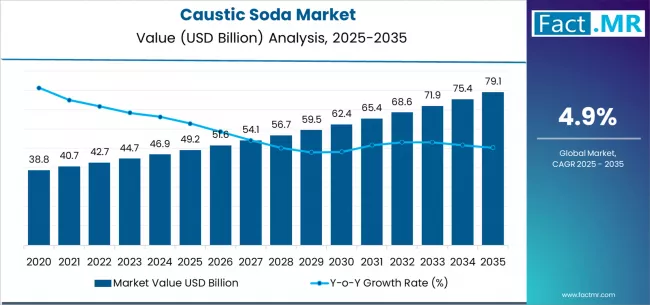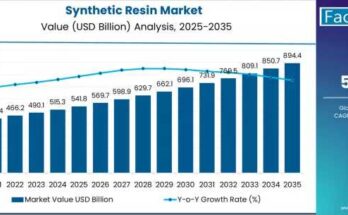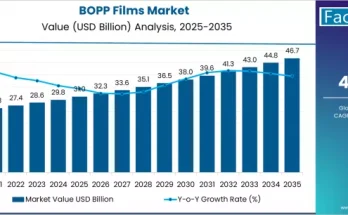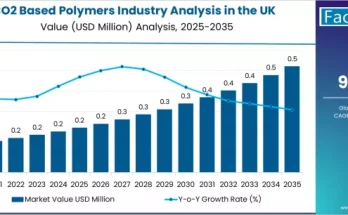The global caustic soda market is poised for steady growth as industrial applications expand across chemical manufacturing, pulp and paper, textiles, water treatment, and aluminum production. Caustic soda (sodium hydroxide) is a critical industrial chemical used as a strong alkali in numerous production processes, including the manufacturing of soaps and detergents, chemical intermediates, and food processing agents.
As of 2025, the global caustic soda market is estimated at approximately USD 54.3 billion. Forecasts suggest that the market will grow to around USD 88.6 billion by 2035, reflecting a compound annual growth rate (CAGR) of about 5.0% over the next decade. Market growth is supported by increasing industrialization, rising demand from emerging economies, and the expanding use of caustic soda in sustainable applications such as water treatment and bio-based chemicals.
Key Market Highlights (2025 Baseline)
-
Market Value (2025): ~ USD 54.3 billion
-
Forecast Value (2035): ~ USD 88.6 billion
-
Forecast CAGR (2025–2035): ~ 5.0%
-
Leading Application Segment: Pulp & Paper (~ 28% share in 2025)
-
Dominant Production Type: Liquid caustic soda (~ 60% share in 2025)
-
Top Regional Market: Asia-Pacific (~ 45% share in 2025)
-
Other High-Growth Regions: North America, Europe, and Middle East & Africa
To access the complete data tables and in-depth insights, request a Discount On The Report here: https://www.factmr.com/connectus/sample?flag=S&rep_id=11990
Growth Drivers & Market Momentum
Expansion of Pulp, Paper, and Textile Industries
Rising demand for paper, cardboard, and textile products globally is driving caustic soda consumption. It is extensively used in pulping processes, bleaching, and textile finishing, supporting demand in both mature and emerging economies. Asia-Pacific, with its growing manufacturing base, remains the largest consumer region.
Increasing Aluminum Production
Caustic soda is a key input in the Bayer process for aluminum extraction. Growing demand for aluminum in automotive, construction, and packaging industries is boosting market consumption, particularly in regions with expanding industrial production such as Asia-Pacific and North America.
Rising Detergent and Soap Production
With growing household incomes and increasing hygiene awareness, demand for soaps, detergents, and cleaning agents is on the rise. Caustic soda is a critical raw material in saponification and chemical formulations, contributing significantly to market expansion.
Growth of Water Treatment Applications
Environmental regulations and increasing urbanization are driving the demand for treated water. Caustic soda is widely used in water treatment to regulate pH, remove heavy metals, and treat industrial effluents. Expanding municipal and industrial water treatment infrastructure supports market growth.
Regional Market Dynamics
Asia-Pacific dominates the caustic soda market due to industrialization, urbanization, and rising production capacities in countries such as China and India. North America and Europe maintain steady growth, supported by high consumption in chemical, pulp, and aluminum industries, as well as technological advancements in production and process efficiency.
Challenges & Market Constraints
-
Volatile Raw Material Prices: Fluctuations in electricity and salt prices, which are key inputs in the chlor-alkali process, can impact production costs and pricing.
-
Environmental and Regulatory Compliance: Production and disposal of caustic soda and related chlorine derivatives must comply with strict environmental regulations, increasing operational complexity.
-
High Energy Consumption: Electrolytic production of caustic soda is energy-intensive, and rising energy costs can constrain profitability and adoption.
-
Competition from Alternative Chemicals: In certain applications, alternative alkalis such as potassium hydroxide may be used, creating competitive pressures in niche markets.
Strategic Recommendations
For Manufacturers
-
Invest in energy-efficient production technologies to reduce operational costs and carbon footprint.
-
Expand production capacities in high-growth regions such as Asia-Pacific to capitalize on industrial and chemical manufacturing demand.
-
Focus on sustainable and environmentally compliant solutions to address regulatory requirements and growing consumer concerns.
For End-Use Industries
-
Incorporate high-purity caustic soda for critical applications in pulp, paper, aluminum, and detergent manufacturing to ensure quality and process efficiency.
-
Explore partnerships with suppliers for consistent supply and pricing stability, especially in regions with volatile energy costs.
For Investors & Market Entrants
-
Recognize caustic soda as a stable, high-demand industrial chemical with applications across multiple industries, providing resilient growth opportunities.
-
Focus on markets with rising industrialization, urbanization, and chemical manufacturing expansion.
-
Explore innovative applications in bio-based chemicals, water treatment, and green manufacturing to capitalize on sustainability trends.
Market Outlook to 2035
By 2035, the global caustic soda market is expected to reach approximately USD 88.6 billion, driven by industrial growth, rising consumption in pulp, paper, and aluminum production, and expanding applications in water treatment and detergents. Asia-Pacific is projected to remain the largest and fastest-growing regional market due to increasing industrialization, urbanization, and manufacturing expansion.
Manufacturers that prioritize energy efficiency, regulatory compliance, sustainability, and innovation in product applications are expected to gain a competitive advantage. With the ongoing demand for durable, high-performance, and environmentally compliant chemical products, caustic soda will continue to play a vital role in global industrial development over the next decade.
Browse Full Report: https://www.factmr.com/report/caustic-soda-market



